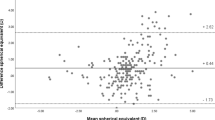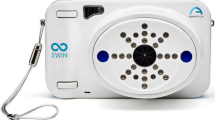Abstract
Purpose
The purpose of this study was to compare refraction measurements for children with the PlusOptix S09 and Spot Vision with cycloplegic retinoscopy.
Methods
One hundred thirty-six eyes of 68 children (26 boys and 42 girls) were evaluated prospectively. The subjects were separated into two groups. Group 1 comprised the subjects age between 5 and 9 years. Group 2 comprised the subjects age between 10 and 18 years. Photorefraction with PlusOptix S09, photorefraction with Spot Vision and cycloplegic retinoscopy were performed in each patient. Spherical equivalents, spherical power, cylindrical power and axis values were compared between three methods.
Results
The mean age of the patients was 7.12 ± 1.5 years in group 1 and 12.24 ± 1.8 years in group 2. Spherical equivalent and spherical power measured with PlusOptix S09 were statistically smaller than measured with cycloplegic retinoscopy for group 1 (p = 0.001, p = 0.001) and for group 2 (p = 0.000, p = 0.000). The mean cylindrical power measured with PlusOptix S09 was not statistically different compared to cycloplegic retinoscopy for both groups (p = 0.314, p = 0.05). Spherical equivalents measured with Spot Vision were statistically smaller than measured with cycloplegic retinoscopy for both groups (p = 0.000, p = 0.012). Spherical power measured with Spot Vision was statistically smaller than measured with cycloplegic retinoscopy for group 1 (p = 0.000), but the difference was not statistically significant for group 2 (p = 0.084). The mean cylindrical power measured with Spot Vision was statistically higher than cycloplegic retinoscopy for both groups (p = 0.000, p = 0.012).
Conclusions
PlusOptix S09 and Spot Vision devices give acceptable results for screening, but prescription of spectacles should not be made according to PlusOptix S09 or Spot Vision devices alone.



Similar content being viewed by others
References
Simons K (2005) Amblyopia characterization, treatment, and prophylaxis. Surv Ophthalmol 50:123–166
Donahue SP, Arnold RW, Ruben JB et al (2003) Preschool vision screening: what should we be detecting and how should we report it? Uniform guidelines for reporting results of preschool vision screening studies. J Am Assoc Pediatric Ophthalmol Strabismus 7:314–316
Pediatric Eye Disease Investigator G (2003) The course of moderate amblyopia treated with atropine in children: experience of the amblyopia treatment study. Am J Ophthalmol 136:630–639
American Academy of Ophthalmology Pediatric Ophthalmology/Strabismus Panel (2012) Preferred practice pattern guidelines: pediatric eye evaluations. American Academy of Ophthalmology, San Francisco
Peterseim MM, Papa CE, Wilson ME et al (2014) The effectiveness of the Spot Vision Screener in detecting amblyopia risk factors. J Am Assoc Pediatric Ophthalmol Strabismus 18:539–542
Peterseim MM, Papa CE, Wilson ME et al (2014) Photoscreeners in the pediatric eye office: compared testability and refractions on high-risk children. Am J Ophthalmol 158:932–938
Garry GA, Donahue SP (2014) Validation of Spot screening device for amblyopia risk factors. J Am Assoc Pediatric Ophthalmol Strabismus 18:476–480
Rajavi Z, Sabbaghi H, Baghini AS et al (2015) Accuracy and repeatability of refractive error measurements by photorefractometry. J Ophthalmic Vis Res 10:221–228
Silbert DI, Matta NS (2014) Performance of the Spot vision screener for the detection of amblyopia risk factors in children. J Am Assoc Pediatric Ophthalmol Strabismus 18:169–172
Erdurmus M, Yagci R, Karadag R et al (2007) A comparison of photorefraction and retinoscopy in children. J Am Assoc Pediatric Ophthalmol Strabismus 11(6):606–611
Demirci G, Arslan B, Özsütçü M et al (2014) Comparison of photorefraction, autorefractometry and retinoscopy in children. Int Ophthalmol 34:739–746
Yan XR, Jiao WZ, Li ZW et al (2015) Performance of the Plusoptix A09 photoscreener in detecting amblyopia risk factors in Chinese children attending an eye clinic. PLoS ONE 10:e0126052. https://doi.org/10.1371/journal.pone.0126052
Mirzajani A, Heirani M, Jafarzadehpur E et al (2013) A comparison of the Plusoptix S08 photorefractor to retinoscopy and cycloretinoscopy. Clin Exp Optom 96:394–399
Fogel-Levin M, Doron R, Wygnanski-Jaffe T et al (2016) A comparison of plusoptiX A12 measurements with cycloplegic refraction. J Am Assoc Pediatric Ophthalmol Strabismus 20:310–314
Author information
Authors and Affiliations
Corresponding author
Ethics declarations
Conflict of interest
All authors certify that they have no affiliations with or involvement in any organization or entity with any financial interest (such as honoraria; educational grants; participation in speakers’ bureaus; membership, employment, consultancies, stock ownership, or other equity interest; and expert testimony or patent-licensing arrangements), or non-financial interest (such as personal or professional relationships, affiliations, knowledge or beliefs) in the subject matter or materials discussed in this manuscript.
Ethical approval
All procedures performed in studies involving human participants were in accordance with the ethical standards of the institutional and/or national research committee and with the 1964 Declaration of Helsinki and its later amendments or comparable ethical standards.
Informed consent
Informed consent was obtained from all individual participants included in the study.
Rights and permissions
About this article
Cite this article
Dikkaya, F., Erdur, S.K. Comparison of the PlusOptix S09 and Spot Vision photorefractor to cycloretinoscopy. Int Ophthalmol 39, 1671–1678 (2019). https://doi.org/10.1007/s10792-018-1026-8
Received:
Accepted:
Published:
Issue Date:
DOI: https://doi.org/10.1007/s10792-018-1026-8




